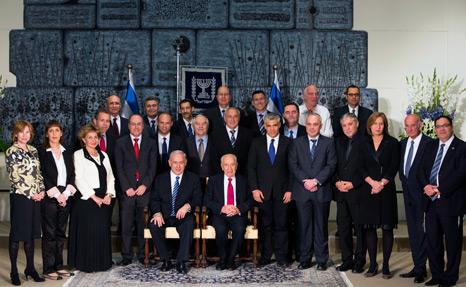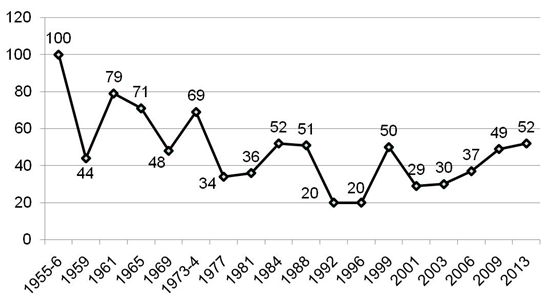The New Israeli Cabinet: An Overview of the 33rd Government of Israel
On March 18, 2013, the 33rd government of the State of Israel—the third Netanyahu cabinet—was sworn in. In this article, IDI Researcher Dr. Ofer Kenig, who heads the political parties' research group of IDI's Political Reform project, presents an overview of the new government.

Introduction
On March 18, 2013, the 33rd government of the State of Israel—the third Netanyahu cabinet—was sworn in. The new government is based on a coalition of four parties that hold a total of 68 seats in the 19th Knesset: Likud-Beiteinu (31 seats), Yesh Atid (19), Habayit Hayehudi (12), and Tzipi Livni's Hatnua (6). The government has 22 ministers, eight less than the previous government. Nine of these ministers are first-term ministers.
The Government Formation Process and the Coalition's Internal Balance of Power
In Israel, the combination of an extreme proportional electoral system and a heterogeneous social structure with many social rifts creates a multi-party system. Every Knesset in the history of the State of Israel has included at least ten parties, and there has never been a single party that has held a majority of Knesset seats. As a result, all of Israel's governments have been coalition governments. In this respect, the new government is no different than its predecessors. It is based on a coalition of four parties that hold 68 seats. This is a smaller majority than the majority that supported Netanyahu's previous government when it was formed after the 2009 elections. At that time, the government relied on a coalition of six parties with a majority of 74 Knesset members.
The process of government formation seems to have been particularly difficult this time, primarily because of the alliance between Yair Lapid and Naftali Bennett—a close cooperation established between the leaders of the two senior coalition partners Yesh Atid and Habayit Hayehudi. The weight of these two parties combined—31 seats—is equal to that of Likud-Beiteinu. This fact, coupled with the adamant refusal of Labor party head Shelly Yachimovich to join the coalition, gave Lapid and Bennett a strong bargaining position. However, though the process of forming the government continued until the very last minute, and included spins, disinformation, and crises galore, the actual data indicate that the coalition-building process was not significantly longer than it had been in previous years. While Netanyahu took until the end of the period of time allocated by law for forming the government, the "gross" length of time (from Election Day until the formation of the government) was 52 days. As can be seen in Figure 1, this is only three days longer than it took to form the previous government in 2009.
Figure 1: The Length of the Coalition Building Process
(in Days) *

* The number of days reflects the "gross" amount of time taken to form the government, from Election Day until the day of the new government's investiture in the Knesset.
The incoming government, like its three predecessors, will be based on a ruling party that is a minority in the coalition. That is, Likud-Beiteinu will have a nucleus of power of less than 50% (31 out of 68 seats). This fact has significant implications for the prime minister’s governance ability. When the prime minister's party is a minority in the government, the constraints of the coalition increase substantially, since the coalition partners have a strong bargaining position. A situation in which a ruling party has a nucleus of power of less than half is a relatively new phenomenon in the political history of Israel. Until 1996, the ruling party usually had a solid majority in the coalition. The exceptions to this rule were the unity governments, such as the governments that were formed after the elections of 1969, 1984, and 1988. Since 1996, however, the power of Israel’s large parties has diminished greatly, and the ruling parties have been at a disadvantage in the coalitions they lead. Of the seven governments since 1996, there was only one (the second Sharon government) in which the ruling party had a majority in the coalition government.
The Size of the Cabinet (Number of Ministers)
The minority status of Likud-Beiteinu is counter-balanced by the fact that it will have a majority among the members of the government (the ministers). Of the 22 members of the new cabinet, 12 ministers belong to Likud-Beiteinu, and an additional ministerial portfolio (foreign minister) has been reserved for Avigdor Lieberman, who is also a member of this party. This majority is a departure from the principle of proportionality in the allocation of ministers. According to this principle, known in Israel as the “coalition formula,” the allocation of ministerial positions is done in a manner that reflects the relative weight of each of the coalition partners. A large partner will receive a greater number of ministerial portfolios than a small party.
In Israel’s 33rd government, the coalition formula was applied differently for each of the coalition partners. If we look at the number of ministerial positions allocated to each coalition partner (Table 1), we will find that Likud-Beiteinu and Tzipi Livni’s Hatnua received more generous terms than the other parties. Hatnua received two ministerial positions, which works out to be one minister per each three of the party’s six Knesset members. This formula is more generous than that the formula used for the other two coalition partners, and is a result of the fact that Hatnua was the first party to sign a coalition agreement. Yesh Atid and Habayit Hayehudi received one minister per approximately every four members of Knesset. Likud-Beiteinu, the ruling party, was allocated portfolios based on the most generous formula of all: one per approximately every 2.6 members of Knesset.
Table 1: Allocation of Ministerial Positions in the
33rd Israeli Government
| Party | Number of Ministers | Number of Knesset Members |
Coalition Formula |
| Likud-Beiteinu | 12 | 31 | One minister per 2.6 MKs* |
| Yesh Atid | 5 | 19 | One minister per 3.8 MKs |
| Habayit Hayehudi | 3 | 12 | One minister per 4 MKs |
| Hatnua | 2 | 6 | One minister per 3 MKs |
| Total | 22 | 68 | One minister per 3.1 MKs |
* If the portfolio reserved for Foreign Minister Avigdor Lieberman
is included in the calculation, the coalition formula used for Likud-Beiteinu is even more generous, and is close to one minister per
every 2.4 MKs.
At the time of the swearing in of the government, the incoming cabinet included 22 ministers. Reducing the size of the cabinet was one of Yesh Atid’s election promises. Although the new government does not consist of 18 ministers, as Yesh Atid party head Yair Lapid promised voters, 22 is a significant decrease from the 30 ministers in the previous government. In fact, the new government has the lowest number of ministers at the time of its swearing in since 1999. In that year, at the time of the swearing in of the government of Prime Minister Ehud Barak, the number of ministers was limited by law to a maximum of 18, but Barak acted quickly do away with the limit, achieving his goal several weeks later and adding five ministers to his government. Limiting the number of ministers in the government is one of the most prominent elements in the commitments regarding political reform included in the coalition agreement. According to the agreement, the incoming government will change the law so that it will limit the number of ministers to 18, prohibit the appointment of ministers without portfolio, and limit the number of deputy ministers to a maximum of four.
.
Profile of the Ministers of the 33rd Government
Israel’s 33rd government includes nine new ministers, eight of whom are from the two parties that are portrayed as the harbingers of "new politics," and only one (Yair Shamir) from Likud-Beiteinu.
Gender
Following the elections, the 19th Knesset has total of 27 women members—a record number. The new government also brings good tidings, albeit moderate, about the presence of women in key positions. For the first time in history, the Israeli government will include four women ministers. Three of them have served as ministers previously (Tzipi Livni, Limor Livnat, and Sofa Landver), while one is serving as a minister for the first time (Yael German).
Age
One of the most striking results of the 19th Knesset election was the large number of young people who were elected: 17 of the Knesset members are under 40 years of age. This phenomenon is not reflected in the composition of the new government. The average age of the ministers in the 33rd government is 58. Only five of the ministers are younger than 50 (at 41, Naftali Bennett is the youngest of them all). In contrast, 11 ministers of over 60, with Uzi Landau (70), Yaakov Peri (69), and Yair Shamir (68) at the top of the list.
Political Experience, Ethnic Origins, and Religious Affiliation
First, it should be noted that all of the members of Israel’s 33rd government are members of the 19th Knesset; no outside professionals have been appointed as ministers. The new government presents a balanced selection of "new faces" and experienced ministers. For nine ministers, this will be their first term at the government’s table. Seven of those nine new ministers are also new members of the Knesset, who do not have any political experience on the national level, while the other two (Uri Ariel and Uri Orbach) have previous parliamentary experience. The ministers with the most seniority are Uzi Landau (since 1984), Prime Minister Benjamin Netanyahu (since 1988), and Limor Livnat (since 1992).
The incoming government includes only two ministers who have a security background: former Chief of Staff Moshe (Bogie) Ya'alon and former Shin Bet chief Yaakov Peri. This representation of ministers with security backgrounds is quite low compared to past governments. The outgoing government, for comparison, included four former security officials: Ehud Barak, Moshe (Bogie) Ya'alon, Yossi Peled, and Avi Dichter.
Only three of the 22 ministers in the incoming government—Silvan Shalom, Meir Cohen, and Amir Peretz—are of Sephardic origin, which is a significant decrease from the outgoing government. As (almost) usual, the government does not include a non-Jewish minister. There have only been two non-Jewish ministers in all of Israel’s history: Salah Tarif (2001) and Raleb Majadele (2007). Unlike the two previous governments, the incoming government does not include any representatives of the ultra-Orthodox sector. However, there are four ministers from the religious-Zionist camp: Uri Orbach, Uri Ariel, Naftali Bennett, and Shay Peron.
Dr. Ofer Kenig is an IDI researcher who heads the Political Parties Research Team of IDI's Forum for Political Reform in Israel.
